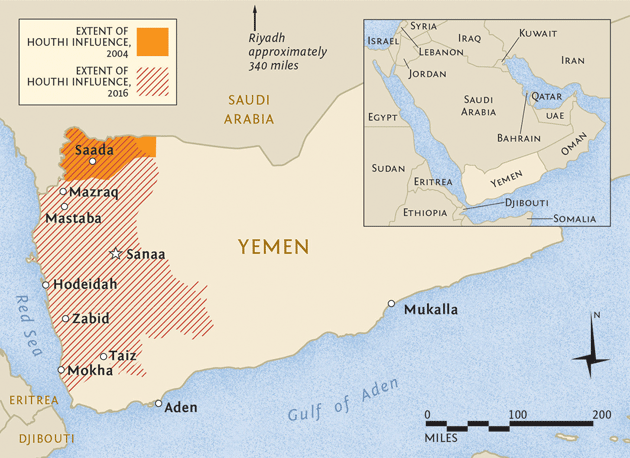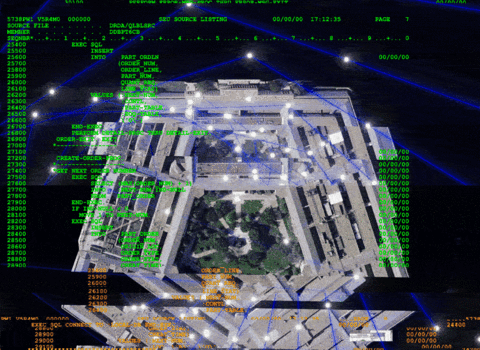Just a few short years ago, Yemen was judged to be among the poorest countries in the world, ranking 154th out of the 187 nations on the U.N.’s Human Development Index. One in every five Yemenis went hungry. Almost one in three was unemployed. Every year, 40,000 children died before their fifth birthday, and experts predicted the country would soon run out of water.
Such was the dire condition of the country before Saudi Arabia unleashed a bombing campaign in March 2015, which has destroyed warehouses, factories, power plants, ports, hospitals, water tanks, gas stations, and bridges, along with miscellaneous targets ranging from donkey carts to wedding parties to archaeological monuments. Thousands of civilians — no one knows how many — have been killed or wounded. Along with the bombing, the Saudis have enforced a blockade, cutting off supplies of food, fuel, and medicine. A year and a half into the war, the health system has largely broken down, and much of the country is on the brink of starvation.
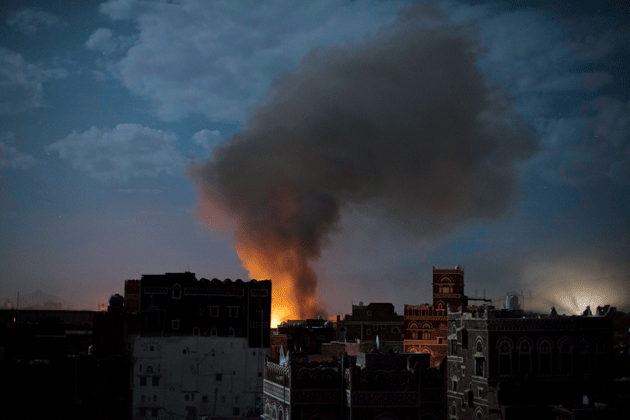
Smoke from an air strike on the al-Oradi Hospital, Sanaa, Yemen, June 9, 2015. Photograph by Alex Potter
This rain of destruction was made possible by the material and moral support of the United States, which supplied most of the bombers, bombs, and missiles required for the aerial onslaught. (Admittedly, the United Kingdom, France, and other NATO arms exporters eagerly did their bit.) U.S. Navy ships aided the blockade. But no one that I talked to in Washington suggested that the war was in any way necessary to our national security. The best answer I got came from Ted Lieu, a Democratic congressman from California who has been one of the few public officials to speak out about the devastation we were enabling far away. “Honestly,” he told me, “I think it’s because Saudi Arabia asked.”
The principal targets of the Saudi bombers (augmented by a coalition of Arab allies) have been a tribal group from the north of Yemen, adjacent to the Saudi border, who follow Zaidism, an offshoot of Shia Islam. Though it is distinct from the variant of Shiism practiced in Iran, the connection was destined to excite the suspicions of the fervently anti-Iranian Saudi regime.
So, almost forty years ago, the Saudis planted an outpost of their own extreme Wahhabi sect in the heart of Zaidi territory. The emissary sent to found the madrassa was Muqbil al-Wadie, a leader of the 1979 assault on Mecca’s Grand Mosque, who had until that moment been rotting in a Saudi prison. As has been their habit, the Saudis solved their own terrorism problem by exporting it.
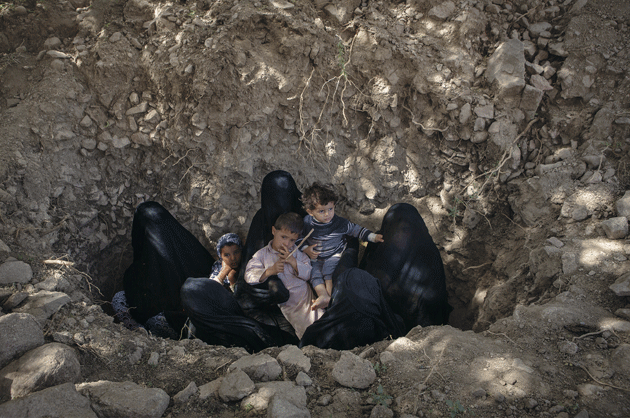
Women and children who were displaced from their village by air strikes seek shelter in the ground near Fella, in Saada governorate, where a local school housed them. When the women hear warplanes or antiaircraft fire, they feel safer in the ground. Photograph by Maria Turchenkova
The intrusive enterprise, which attracted a growing stream of militant Sunnis, eventually provoked a reaction among the local Zaidis in favor of their Shia tendencies. Accordingly, under the leadership of Hussein al-Houthi, they sought religious instruction from Iran in the form of teachers and literature, which were duly supplied, much to Riyadh’s irritation.
For many years, this Iranian connection was treated with equanimity by Yemen’s president, Ali Abdullah Saleh. Following 9/11, however, he came under pressure from Washington to play his part in the war against Al Qaeda, which had been active in Yemen since the late 1990s. Saleh found this mission unappealing, given the terrorist group’s connections with some of the country’s most powerful political forces. According to Abdul-Ghani al-Iryani, an activist whose family has long played a leading role in the nation’s politics, Saleh suggested to the Americans that he first deal with the Shiite troublemakers in the north. “From day one,” Iryani told me, “the Houthis were presented as an Iranian client, a terrorist movement.” This policy, unsurprisingly, was greeted with favor in Riyadh, and reciprocated with commensurate financial largesse.
Privately, U.S. officials were doubtful of the Iranian connection, even at the beginning of Saleh’s campaign against the group in 2004. “The fact that after five years of conflict there is still no compelling evidence of that link must force us to view this claim with some skepticism,” wrote the U.S. ambassador to Yemen, Stephen Seche, in a classified 2009 cable later released by WikiLeaks. Nevertheless, the Americans were eager to secure Saleh’s cooperation against Al Qaeda. They did little to restrain him in his war with the Houthis, as they came to be called following the death of Hussein al-Houthi in 2004.
In 2009, hoping for a final victory, Saleh managed to involve the Saudis directly by eliciting their permission to send Yemeni troops across the border to attack the Houthis from the rear. In response, a small force of Houthis invaded Saudi Arabia. Adding to the complications, Yemen now became embroiled in Saudi court politics: Khalid bin Sultan, the prince who effectively controlled the defense ministry, moved to assert dominance at the expense of a rival prince at the interior ministry, using the Houthi incursion as an excuse. Promptly declaring the southern portion of the country a “killing zone,” he mobilized the entire Saudi military. The air force carpet bombed the border region, including Saada, the Houthi heartland.
The result, however, was a humiliating setback for the House of Saud. Their ground troops were bested by the Houthis and suffered numerous casualties. The aerial campaign was no more impressive. “It was not a moment of glory for the Saudi air force,” according to David Des Roches, who formerly oversaw Saudi-related policy at the Pentagon and is now an associate professor at the National Defense University. “They were basically just dropping rounds in the desert.” A senior U.N. diplomat put it to me more bluntly: “They lost.”
Saleh’s own offensive was equally ineffectual, and the Houthis were left to fight another day. Meanwhile, Yemen’s ill fortune proved a blessing, not for the last time, for the U.S. defense establishment. The Obama Administration was already bent on expanding arms sales as part of its drive to boost exports, and now manna fell from heaven. Shocked by their poor performance against the Houthi guerrillas, the Saudis embarked on a massive weapons-buying spree.
At the top of their shopping list were eighty-four specially modified Boeing F-15 jets, along with around 170 helicopters. They also purchased a huge quantity of bombs and missiles — notably, 1,300 cluster bombs sold by the Textron Corporation at a cost of $641 million. Fortunately for Textron, neither the United States nor Saudi Arabia had endorsed the Convention on Cluster Munitions, a 2008 treaty already signed by more than one hundred nations, which banned these weapons on the grounds that they caused “unacceptable harm” to civilians.

A man in an underground shelter on the outskirts of Saada city, which was hit by a series of Saudi-led air strikes in May 2015. Photograph by Maria Turchenkova.
This enormous deal totaled $60 billion: the largest arms sale in U.S. history. The scale of the transaction says much about America’s relationship with the House of Saud. The bond was forged at a 1945 meeting between President Franklin Roosevelt and King Abdulaziz, with both parties agreeing that Saudi Arabia would guarantee the United States cheap oil in return for American military protection. Both sides largely kept to the bargain. The Saudis even subsidized the price of oil exported to the United States — at least until 2002, when they abandoned the policy out of irritation at George W. Bush’s plan to topple the Sunni regime in Iraq.
America’s adherence to its side of the deal is most concretely manifested in a housing compound a dozen or so miles outside Riyadh. Eskan Village is home to 2,000 Americans, military and civilian, dedicated to the security of the regime. For the U.S. military, it is a gratifyingly lucrative arrangement. Some inhabitants of the compound supervise the arming and training of the Saudi National Guard — a mission that has so far generated $35 billion in U.S. military sales. Others are attached to the U.S. Military Training Mission to Saudi Arabia, which services the regular armed forces. According to its website, this group is charged with enhancing American national security “through building the capability and capacity of the Saudi Arabian Armed Forces” — a task that absolutely includes acting as an “advocate for U.S. business to supply defense goods and services to the S.A.A.F.” In other words, the Saudis host a sales team dedicated to selling them weapons. Furthermore, they fund its upkeep, paying roughly $30 million a year for the privilege.
As Des Roches reminded me, the U.S. government is the official vendor for weapons sales on behalf of corporations such as Boeing and Textron. “We levy a surcharge for the U.S. government’s involvement,” he explained, reminding me that the sale of the F-15s and other assorted items ran to $60 billion. “Seven percent of that is a significant amount of money,” he continued. “That basically covers U.S. government operating expenses to run things like training for the Bolivian armed forces in counternarcotics, and stuff like that. Up until very, very recently, the Saudis pretty much subsidized everything. People do not realize how much benefit we get from our interaction with them.”
This long relationship has sunk deep roots in the U.S. defense establishment, especially since close acquaintance with the free-spending Saudi hierarchy can lead to attractive postretirement opportunities. David Commons, for example, the Air Force general who directed the military mission from 2011 to 2013, was responsible for what he calls the “management and execution” of the huge 2010 arms sale. It should come as no surprise, therefore, that on his return from Saudi Arabia he turned to commerce, where his Middle Eastern connections could be put to good use. First he chaired the Sharaka Group, offering “knowledge, experience, and tenacity” in navigating the “maze” of Saudi bureaucracy. Next he cofounded Astrolabe Enterprises, which, by his account, helps the Saudis buy American weapons. “If they need a capability,” he told me, “we are there.”
One capability of which the Saudis are certainly in need is keeping their expensive toys in working order, a lucrative prospect for firms such as Astrolabe. By 2015, the maintenance contract for the F-15s alone was worth $2.5 billion. Almost all the technically demanding work on the highly complex plane, especially on its electronics, appears to require the services of American contract workers. This has led to something of a gold rush for mechanics and engineers. TS Government Solutions, of Lake Elsinore, California, is currently looking for maintenance mechanics “in support of RSAF F-15 platform throughout Saudi Arabia. . . . VERY lucrative comp plan.” There are no less than 1,471 openings listed on the website of ManTech International, of Fairfax, Virginia, the recipient of a $175 million F-15 maintenance contract. “Every time I looked at someone doing something technical on an F-15, it was an American contractor,” Chet Richards, a former Air Force Reserve colonel who served several tours as an air attaché in Riyadh, told me. “These are really, really complex systems. We have trouble keeping them flying in our own air force.”
Other features of the U.S.–Saudi security relationship are more obscure, such as the “secret” CIA drone base deep in the southwestern desert, which became operational in 2011 and has been periodically rediscovered by the media in subsequent years. Dedicated to launching drone strikes against Al Qaeda in Yemen, it was a fruit of Saleh’s delicate balancing act, whereby he tacitly endorsed the ongoing U.S. assassination campaign against Al Qaeda leaders while avoiding direct action against the group himself. Indeed, even as the drones regularly incinerated Al Qaeda members along with innocent bystanders and the occasional wedding party, Saleh not only declined to arrest the terrorists but on occasion provided them with safe houses in Sanaa. Ignorant of (or perhaps unconcerned by) this double-dealing, Washington continued to indulge the wily Yemeni leader with copious aid and training missions.
This comfortable arrangement became unstuck in early 2011, when the so-called Arab Spring reached Yemen. The populace united in massive demonstrations against the president’s dictatorial and corrupt rule. Wounded in an unsuccessful assassination attempt, Saleh eventually resigned in favor of his vice president, the former army general Mansour Hadi. Endorsed by both the United States and Saudi Arabia, Hadi ran for election in 2012 and won with 99 percent of the vote — hardly a surprise, given that he was the only candidate. He quickly launched a “national dialogue” with the aim of reconciling Yemen’s many tribal and regional factions. This failed to mollify the Houthis, who felt (somewhat reasonably, according to Ambassador Seche) that they were being dealt out of the new arrangements. In September 2014 they marched into Sanaa and, not long afterward, placed Hadi under house arrest.
Meanwhile, there had been ructions north of the border. King Abdullah died in January 2015, at the age of ninety, and was succeeded by his seventy-nine-year-old half brother, Prince Salman. Suffering from dementia, Salman reportedly could function at meetings only by reading prepared talking points off a monitor masked by a vase of flowers. It soon became apparent that real power had devolved to his twenty-nine-year-old son, Prince Mohammed bin Salman, who in short order took control of the defense ministry as well as the royal household.
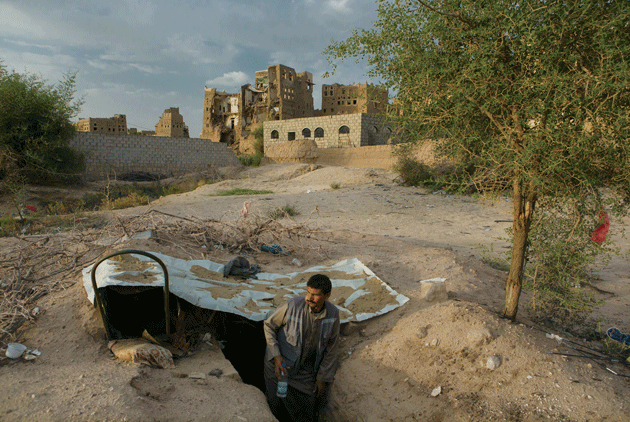
A man stands in a shelter dug into the ground in Rahban, on the outskirts of Saada city. Much of Rahban was destroyed by a series of air strikes in March 2015. Photograph by Maria Turchenkova
The Saudi regime has traditionally ruled by consensus. A previous king, Fahd, once told an American envoy that he had made only one decision in fifty years: inviting the Americans to expel Saddam Hussein from Kuwait in 1990. But Mohammed cut through the venerable system of checks and balances, imposing decisions that were, according to one former American diplomat with long experience of the Saudis, “bold, not to say rash.”
Given his nation’s long-standing readiness to see “a Persian under every khat bush,” as the diplomat put it, Mohammed was eager to try out his expensive new weapons. He could crush the Houthis with a quick campaign and thereby shore up his own position at the expense of potential rivals in the ruling family.
On March 26, 2015, having secured a request for intervention from Hadi, the Royal Saudi Air Force went into action. The United States announced it was supplying “logistical and intelligence support.” Five days later, the Saudi-led coalition imposed a comprehensive air and sea blockade of Houthi-held areas, including Hodeidah, the principal port serving northern Yemen. For a population that relied on imports for at least 90 percent of its food, not to mention almost all other essentials such as fuel, cooking gas, and medicine, the effect would be devastating.
Following standard practice in modern air campaigns, initial strikes targeted the Yemeni air force and air defenses, using high-tech bombs and missiles that allegedly guarantee precise accuracy. The Saudis may even have believed the arms merchants’ sales pitches: a few days after the bombing began, a senior Saudi diplomat assured U.N. officials that the use of “very precise weapons” would prevent any collateral damage among the civilian population. In any event, the Saudis had little need to fear diplomatic censure at the United Nations. A Security Council resolution effectively demanding unconditional surrender from the Houthis passed with American support.
U.S. diplomatic cover would be unstintingly maintained as the war raged on. In September, six months into the bombing, the Dutch government sponsored a resolution in the U.N. Human Rights Council calling for an independent and unfettered investigation into war crimes committed by all sides in Yemen. The Saudis strenuously objected, demanding that any such investigation be left in the hands of the deposed President Hadi, who was living in exile in Riyadh. The United States declined to support the Dutch, effectively killing the idea. In an officially cleared background interview, I asked a senior State Department official why the United States had acted as it did.
“The Yemenis didn’t want it,” he replied, by which he meant Hadi.
“Does the United States usually do what Mr. Hadi wants or doesn’t want?” I asked.
“Well, when we agree with him, yes,” he answered with a smirk.
In fact, the Obama Administration’s support for the Yemeni adventure was never in doubt, if only because it had much bigger diplomatic fish to fry — most notably, the nuclear deal with Iran, the centerpiece of Obama’s foreign-policy agenda, which was impending at the time the war began. “The negotiations were not complete,” I was told by William Luers, a former senior diplomat deeply involved in back-channel talks with the Iranians. “The opposition from Israel and the Gulf to the Iran deal was very strong.” Under the circumstances, he suggested, Obama could ill afford to alienate his Arab partners — and surely the Yemeni conflict wouldn’t last long. “Once they were involved in support of the Saudis,” Luers said, “they couldn’t back out.”
Civilians began to die early on the day the war started. Among the first were three young sons of Yasser al-Habashi, a grocery-store owner whose home on the outskirts of Sanaa was hit by a bomb around two in the morning on March 26. Habashi himself woke up in a hospital after thirteen days in a coma. “There is nothing left of my house that I lived in,” he said later, “and on top of all this, three of my children were killed.”
Five days into the assault, the attackers leveled Yemen’s largest cement factory, killing at least ten people, most of them employees preparing to head home on a bus. A further thirty-one workers died when bombers struck the Yemany Dairy and Beverage factory on the coast. A strike on a refugee camp at Mazraq, full of people who had fled the bombing in Saada and elsewhere, killed forty-five and injured two hundred more.
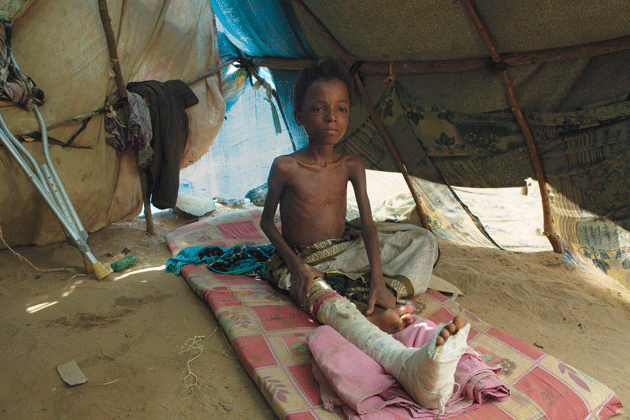
Aziz, eleven, at the Beni Hassan refugee camp in Hajjah governorate. He was injured
in the Saudi-led air strike on the Mazraq refugee camp, in March 2015, which killed
forty-five people and wounded two hundred. Photograph by Maria Turchenkova
The Saudi’s education in aerial targeting had been the best that money could buy. A week before the war began, they had approached John Brennan, an old friend from his days as CIA station chief in Riyadh and now the agency’s director, with a list of more than a hundred potential targets. Reporters were later told that American defense and intelligence officials had reviewed the list and suggested some amendments, removing targets of little military value and others that might endanger civilians. In addition, the United States agreed to help man the coalition’s joint operations center with a liaison group that would advise the Saudis on how to hit their targets most effectively. The group would also ensure that U.S. Air Force tankers were on hand to refuel bombing sorties, a duty they performed more than 700 times by February 2016 — charging, of course, for the gas.
As reports of civilian casualties and Houthi advances seeped into the media, administration officials began to nurture some misgivings. On April 7, two weeks into the war, Tony Blinken, the deputy secretary of state, arrived in Riyadh, the first State Department official to meet one-on-one with the hyperactive and increasingly powerful Prince Mohammed. Blinken’s public message was one of unqualified support for the war. “Saudi Arabia is sending a strong message to the Houthis and their allies that they cannot overrun Yemen by force,” he told reporters. “As part of that effort, we have expedited weapons deliveries [and] increased our intelligence sharing.”
In private, however, Blinken had an urgent question for his hosts. According to diplomatic sources, he asked: What were they actually trying to accomplish in this war? “Eliminate all traces of Iranian influence in Yemen,” the Saudis answered blithely. American officials blenched at the prospect of a Houthi-extermination campaign, but they gave their blessing to what seemed like a more modest goal: preventing a Houthi takeover of all of Yemen and restoring the “elected president” to power.
Indeed, as Iryani explained to me, the allies had put all their chips on Hadi. “The Saudis and Americans believed that once the bombing started, Hadi would be able to rally loyal elements in the army and regain control,” he said. “But it turned out that the entire military was with Saleh. Hadi had no influence at all.” So the war went on, with the Houthis and Saleh’s forces advancing steadily despite the bombing.
In August, after visiting Sanaa and Aden, Peter Maurer, the head of the International Red Cross, declared that “Yemen after five months looks like Syria after five years.” Maurer attributed this not only to the fighting and bombing but to the ongoing blockade. A day earlier, coalition planes had bombed the vital port of Hodeidah, carefully targeting cranes and other necessary equipment.
The port city of Mukalla, however, was left completely unmolested, despite the fact that it was now controlled by Al Qaeda, the object of so many U.S. drone attacks in previous years. The takeover, in April 2015, had been a peaceful one. Saudi-backed forces evacuated the city with barely a shot fired. Al Qaeda would continue to occupy the city and most of eastern Yemen, enriching itself in the process, over the following year. In bitter fighting for the city of Taiz in February 2016, Al Qaeda fighters formed a crucial component of the Saudi-backed anti-Houthi forces.
In Washington, I asked an intelligence official in close touch with the Yemeni situation, who asked not to be named, what the Saudi plan had been at the outset. “Plan?” he replied in exasperated tones. “There was no plan. No plan at all. They just bombed anything and everything that looked like it might be a target. Trucks on a highway — that became a military convoy. Buildings, bridges, anything. When they did find a military target, they bombed it, and then went back and bombed it again.”
There may have been a certain military logic to the repeated strikes on the mountains surrounding Sanaa, into which Saleh had burrowed ammunition dumps over the years. Still, these attacks were catastrophic for people living in nearby neighborhoods. On April 20, 2015, a powerful bunker-buster bomb hit one such dump on Faj Attan mountain, setting off a massive explosion that wrecked houses over a wide area, including Iryani’s. “The mountain exploded,” he told me soon afterward. “About a thousand people were killed or injured. All the children I know are traumatized. Everyone I know knows someone who’s died.”
For hundreds or thousands of strikes, there was less excuse, or none at all. In mid-April of 2015, for example, there appears to have been a concerted attempt to destroy all the gas stations in Saada, which was already being heavily attacked. Thanks to the blockade, fuel was scarce, and drivers would spend hours or days waiting in line to fill up. That was how at least five people died and twenty-three were injured on April 15 — the number of victims is actually unclear, since so many were burned beyond recognition. Several weeks later, on May 8, the coalition declared that the entire 4,000-square-mile governorate of Saada was now a “military target,” and therefore open to indiscriminate attack. In the weeks and months to come, much of the province’s ancient capital city was reduced to rubble, a fate shared by towns and villages across the north, where cluster bombs were heavily used.
“I witnessed about a thousand air strikes,” recalled Tariq Riebl, an aid worker with a major international humanitarian organization who traveled extensively in Yemen from June to September last year. “Some of them were very close. I almost burst my eardrum in one.” In Sanaa, he said, the strikes were relentless, lasting up to five hours. “You’d have that four to six times a day. It would start randomly. It was the middle of the night, middle of the day, morning, night, afternoon, anytime. Consistently on holidays, on Fridays, in the middle of prayer time, market days.”
Crowded markets appear to have had a particular attraction for the targeteers. Human Rights Watch documented a dozen such attacks across northern Yemen, including five in Saada alone. On May 12, for example, three bombs, five minutes apart, hit a market in the Houthi-controlled town of Zabid, killing at least sixty civilians. Another attack killed sixty-five on July 4. In the deadliest market attack to date, on March 15, 2016, two bombs in the village of Mastaba killed at least ninety-seven people, including twenty-five children. Many of the victims died as they fled the scene of the first strike only to be hit by the second, a notable example of the double-tap technique frequently employed during the campaign. “When the first strike came, the world was full of blood,” Mohammed Yehia Muzayid, a cleaner at the market, told Belkis Wille, a researcher for Human Rights Watch. “People were all in pieces, their limbs were everywhere. People went flying. Most of the people, we collected in pieces, we had to put them in plastic bags. A leg, an arm, a head. There wasn’t more than five minutes between the first and second strike. The second strike was there, at the entrance to the market. People were taking the injured out, and it hit the wounded and killed them.”
Metal fragments retrieved from the scene were revealed to be from U.S.-manufactured GBU-31 satellite-guided bombs, a thousand of which were included in a $1.29 billion weapons sale to the Saudis in November 2015. I asked the senior State Department official if there was ever any consideration of refusing such deals. He responded by suggesting that supplying high-tech precision weapons was essentially a humanitarian gesture: “If you want the Saudis to be able to limit collateral damage, then it’s not particularly useful not to give them the weapons that would be most effective in doing that.”
Congressman Lieu thought this a “very lame excuse” when I quoted it to him. “The law of war doesn’t say, ‘Hey, we have the precision-guided-munitions exception.’ It says, ‘You cannot target or kill civilians.’ ”
Lieu could be considered an authority on this topic, since he is a colonel in the Air Force Reserve and spent four years as an active-duty JAG lawyer, instructing military personnel on the law of war. He was convinced that the Saudis and their allies were in violation of those very statutes. He was especially concerned by the use of cluster bombs, which he categorized as a “war crime if you drop them on civilians.”
Six months into the war, Lieu wrote to the chairman of the Joint Chiefs of Staff, General Joseph Dunford Jr., asking if he believed that Yemeni civilians were being deliberately targeted. The answer was classified, but it seems reasonable to assume it was negative. Belkis Wille has a more complicated view. She told me she would often spot some kind of military installation near a bombed civilian site, which may have been the intended target. On the evening of July 24, for example, the coalition bombed a housing compound for workers of the Mokha power plant, in the southwest corner of Yemen. Sixty-five people were killed, including ten children. At least forty-two more were wounded, several of them critically. Wille concluded that the intended target was a military air-defense base, which had been empty for many years, according to unanimous local testimony. More to the point, the base was half a mile away, and easily distinguishable from the compound. “There may have been a lack of good military intelligence,” she told me. “But the end result was an incredibly high rate of sloppiness and recklessness.”
Others are less forgiving. Tariq Riebl concluded that the civilian targets were not an accident. “Let’s be very clear,” he told me. “The civilian targeting is absolutely astounding. I’ve seen hospitals, mosques, marketplaces, restaurants, power plants, universities, residential houses, just bombed, office buildings, bombed. Everything is a target. In Saada, there were dead donkeys on the side of all the main roads because the Saudis were hitting donkey carts. In Hajjah, the water tank in one of the towns got hit, and it sits on a lonesome little hill. There was nothing there. When you’re hitting a donkey cart or you’re hitting a water tank, what is your rationale? Is that donkey cart transporting a Scud missile? What is the thinking here from a military perspective?”
According to Ahmed Assiri, a brigadier general in the Saudi army and a coalition spokesman, the “work” was not “random.” Occasional “mistakes” were due solely to “human error.” In a January 31 press conference, Assiri addressed the particular case of the Doctors Without Borders hospital in Hayden, destroyed last October by air strikes — one of three of the organization’s facilities to be hit during the war — leaving 200,000 people in the region without access to lifesaving medical care. The group had repeatedly relayed the hospital’s GPS coordinates to the Saudis, most recently three days before the strike, and prominently displayed their logo on the roof.
An otherwise unidentified “frontline observer,” explained Assiri, had spotted a target that was “of high value” and relayed the news to a patrolling coalition attack plane. This target, presumably an individual, moved closer to the hospital, and the pilot, seizing an opportunity, attacked. “But there were side effects,” Assiri continued, “causing the collapse of a big part of the hospital.” (In fact, it was utterly demolished.) It seems that the frontline observer did not check with the command center as to whether the hospital was a restricted target — and in any case, the pilot overlooked the logo on the roof, “which was very small and cannot be seen by eye.” (A spokesman for the organization, Tim Shenk, assured me that the logo “clearly identified” the hospital.)
From the professional perspective of Des Roches, the Saudis and their partners have not done badly at all. “Twenty-eight hundred [killed] for a yearlong bombing campaign?” he told me, using a U.N. figure from January. “That’s one night in Hamburg in World War Two.” In fact, the number of civilians killed from the air in a year, he suggested, bore favorable comparison with NATO’s record in the 1999 air campaign against Serbia, the so-called Kosovo War, in which some 500 civilians died from allied air strikes in barely three months. The Saudis, in his view, were “showing restraint. They’re showing a degree of technical expertise.”
As of February 2016, the Saudis noted that the coalition had flown more than 46,500 sorties over Yemen. By July, sixty-nine strikes studied in detail by Amnesty International and Human Rights Watch had killed 913 civilians, at least. As of June, the World Health Organization reported nearly 6,500 dead and more than 31,400 injured, on the basis of information from hospitals around the country. But Doctors Without Borders officials insist that they alone have treated more than 37,000 people with war-related injuries. In any case, more than half the population lacked access to any health care, let alone hospitals.
“As you can of course imagine, those numbers are an underestimation, as people might not bother to take their killed relatives to the hospital just to be counted,” observed Alvhild Strømme, a W.H.O. spokesperson, in a candid email. “I am sure there are many more, especially killed, but also wounded.”
Just over a year after the onslaught began, the Saudis and Houthis called a halt, declaring a ceasefire and beginning peace talks. Bitter fighting has continued in parts of the country, especially around Taiz, where the Saleh-allied Houthi forces, themselves no angels, have nonchalantly shelled civilian areas. Though air strikes slowed, they have continued into the summer, inflicting a steady toll of civilian deaths. Al Qaeda was meanwhile permitted to evacuate Mukalla with all its equipment. Disappearing into the countryside, the terrorist group began a series of deadly bombing attacks. U.N. officials talked of a “humanitarian catastrophe” and issued a call for $1.8 billion in emergency funds. By July, the United States had contributed $148 million, just over 8 percent of the requested amount. Meanwhile, weapons sales to Saudi Arabia over the course of the Obama Administration had topped $111 billion.
The country is in ruins, like Abdul-Ghani al-Iryani’s own house. “Yemen,” he told me sadly as the explosions continued, “is such a small part of the U.S.–Saudi relationship.”

